At the beginning of 2004, the mapping process of religion and spirituality in Aarhus was completed, and the manuscript of the book presenting its results had been submitted to the publisher. Evaluating the course of the project so far, we summarize that the original project description (see the section below) has been put into practice, with only few corrections along the way. We ascribe this positive outcome, i.e. our intentions passing the empirical examination, to the fact that we had a qualified, and an enthusiastic cooperation all along the course of the project. The representatives of the religious and spiritual groups concerned gave us a warm welcome, and were at disposal for the 73 MA candidates and students, who recorded interviews as well as observations in the most brilliant manner. For those without the gift of knowing the Danish language, a special issue of Occasional Papers / Aktuelle Skrifter , published by the Centre for Mutireligious Studies, is under preparation. In this special issue the results of the mapping can be studied through abstracts of the chapters in " Religiøs Mangfoldighed ", including a short introduction to all the religious and spiritual groups of Aarhus, as well as maps and address information. This information will also be published through our homepage, as soon as it is completed.
In addition, our homepage will keep you updated in all aspects: The continuation of the project will be described, partly as surveys in terms of the national and global levels, and partly as a site featuring the analytic and interpretive research efforts, in order to broaden as well as deepen the understanding of religious pluralism in the post modern era. In the following subsections, we will introduce a few topics of the evaluation process.
The most significant observation, which was documented through the mapping process, gave evidence to the societal flow from mono - towards multi-religiosity. Beyond doubt, this proved most essential in our evaluation so far. As a modification, however, Aarhus – as well as the rest of Denmark – is transforming at a slower pace, compared to most other Western countries. This fact is due to the influence of the Evangelical Lutheran Church in Denmark (the national church), and its accommodating 80% of the entire population as members. Nevertheless, the direction leaves no doubt where we are heading: towards an intensified religious diversity – or market exchange, if you like – caused by the dynamics of globalisation and its outcome, a greater supply at the disposal for the individual.
This development has been accompanied by the entry of several religious organisations. But in general, they boast only small figures when it comes to core members, which in effect lead them into a fragile position. And as a result, we can watch the dynamics of religious communities evolving in the field whilst others must give up. Furthermore, a successful arrangement does not necessarily add to membership figures. In fact, the situation has created a shopping mentality, because many people feel free to select activities and social events out of their own needs. But this interest only creates a limited sense of obligation in favour of the religious groups. This pattern also affects the Evangelical Lutheran Church in Denmark because a growing number of its members enjoy the inspiration of different religious groups or phenomena as well. And in some way or other, this influence is reflected in the religious conduct of the clergy.
In everyday conversations, religion has somewhat ambiguous connotations, insofar as it is identified with great cultural achievements as well as dogmatic bigotry. Therefore, quite a few people with interest in our subject neither commit themselves into any particular religion, nor do they identify themselves as religious persons. Instead, they like to be called spiritual seekers, i.e. individuals recognising that life is more than physical objects and material wealth. In this way, “spirituality” has become a buzzword from the perspective of those interested in new religious phenomena or aspects hereof. This includes a variety of Oriental, Christian, Theosophical, and Neopagan observances. This attitude of animosity against religion although deeply involved in a self-proclaimed spiritual development, is respected as a statement by researchers of religion, but nevertheless those who claim this attitude, are considered within the scope of religious studies. A question to be answered in the time to come is whether the amount of resourceful core members will be sufficient for the care of all the seekers, or not.
Those who regard themselves as seekers, however, do not engage in spiritual and religious groups on any full schedule, not to say occupy themselves with spiritual concerns, exclusively. The interest of the seeker could be stimulated by means of education, books, mass media, internet, travelling, etc., and may be activated because of the outburst of physical illness or psychic crisis, followed by the interference of a healer or therapist. To throw some light on these questions, we decided to include practitioners of alternative medicine in our mapping process, also in order to exemplify the extent and the functionality of unconventional spiritual environments. On their side, the practitioners responded in a very positive manner. This can be illustrated by the response rate of our comprehensive questionnaire, which amounted to 170 out of 385. The result of this enquiry is elaborated in the abstract on Alternative Medicine and Spirituality.
The trend towards religious diversity is amplified by the presence of the ethnic minorities. Talking about Hinduism and Buddhism, their followers among the ethnic minorities have practiced their religions without much attention from the majority surrounding them. And in case these religious activities have created any attention, it has been positive, sometimes even to the extent of fascination. The subdivision of ethnic minorities practicing Hinduism consists of Sri Lankan Tamils as the major part and ethnic Indians is the second largest group, whilst the Buddhist subdivision refer to Vietnamese, Thai, Chinese and Japanese for most part, plus a few Koreans, Burmese, and Tibetans.
Following the general trend, however, these Hindu and Buddhist groups are short of resource persons to organise and perform the religious activities of the communities. On top of this, the generation issue must be handled in a proper manner. If not, the generations to take over cannot commit themselves to take responsibility, i.e. for the continuing process of balancing loyalty to the religious tradition of their ethnic homeland, with the adaptation of central values from their new environment.
The religious practice among Hindus, Buddhists, and Muslims of non-Danish ethnic origin, appear in its most vivid fashion in the great ritual ceremonies destined for many followers to participate.
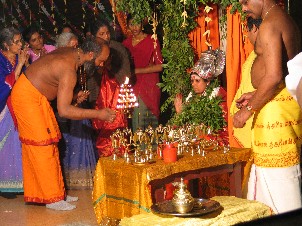 | 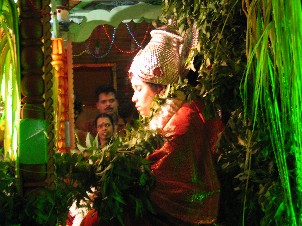 |
Above: A Tamil ceremony is taking place in the AbiramiTemple in Brande . Photos: Marianne Qvortrup Fibiger
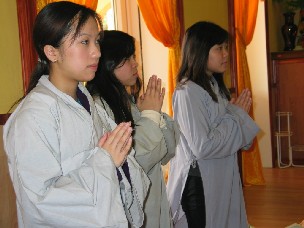 |  |
Above: A Buddhist ceremony among ethnic Vietnamese in the Quang HuongTemple in Tilst. Photos: Jørn Borup
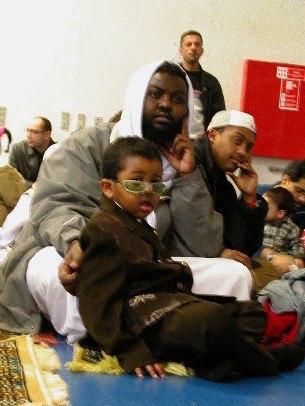 | 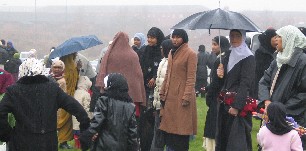 |
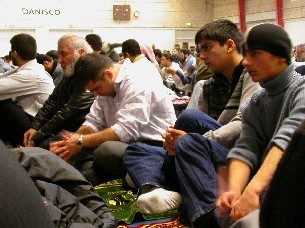 |
These photos were taken at the conclusion of the Ramadan, when celebrated by Muslims from the Aarhus area.
Photos: René Dybdal Pedersen and Lene Kühle
Looking at the sheer statistics of the groups with an Islamic confession, the Muslims in question are better equipped to overcome the obstacles that they face as a religious minority, if we compare with Hindu and Buddhist groups. But intrinsically, the Muslims are subdivided into fractions that reflect their specific ethnic origin as well as dogmatic criteria, and their basic relationships to certain mosques. Therefore, to some degree we recognise the significant structure of a small amount of core members and communities without the optimal religious attendance. Likewise, the generation question is open, in terms of the interpreted obligations connected with religious and cultural traditions of the home countries, and how to renew this heritage in harmony with the Danish cultural and societal context.
Contrary to the Hindus and the Buddhists, however, the Muslims are understood and labelled by a segment of the ethnic Danes as one large, unified group with strong religious ties and fundamentalist tendencies. As a consequence, the Muslims are seen as threat against Denmark and its traditional Christian heritage, by a group of ethnic Danes of primarily rightist political observance. At the same time it must be stressed that the relationship between the Christian churches and the Muslim communities in Denmark is harmonious at the general level, which is expressed through various religious dialogues and other shared initiatives. Representatives of both religious traditions now and then have stated that their primary object of antagonism is exceeding materialism and an ignorant attitude to religion.
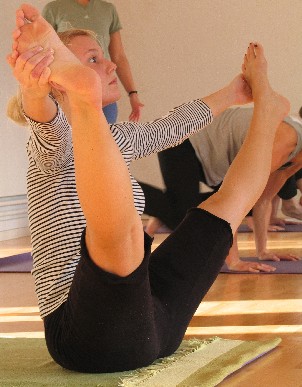 |
On the personal level, many ethnic Danes have been receptive to Hinduism, Buddhism, and Islam out of a miscellany of motifs and levels of interest. One example is yoga, which is a complex system of exercises designated as a disciplinary process of the ego, and in a wider perspective the reunion of the self and the universe. Especially, the physical exercises of yoga have won approval among the Danes, including the citizens of Aarhus. Photo: René Dybdal Pedersen
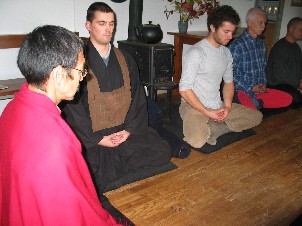 |
Like Hinduism, Buddhism originated from India, and focused from the beginning at the disciplinary process of the ego as well. Following this trail, several methods of meditation have been developed as instruments for the cultivation of the mind. On the national and local levels, these methods to achieve mindfulness, as a famous Vietnamese monk and Buddhist master, Thich Nhat Hanh , expresses it, have appealed to a number of ethnic Danes. His spiritual colleague, The Dalai Lama, has created a very positive atmosphere for the dissemination of Buddhism through his message of compassion for all sentient beings. Photo: Jørn Borup
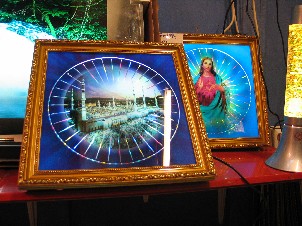 |
Among the ethnic Danes, special interest and conversion into Islam first and foremost are motivated by social relations, for example through the marriage with a Muslim. Other decisive factors include the sense of righteousness, and the prescribed social conduct, which is part of Islamic practice. As a third factor, the study of Islam has led outsiders to a life-long commitment, in some cases. To some Danes, Islam still hasn’t ceased to appear foreign and exotic, although it holds the position as the second largest religious tradition in this country. But in comparison with Christianity’s more than thousand years of history in Denmark, Islam only began its expansion here less than 40 years ago. The God of the Bible, however, is also the God of Islam, and in the latter capacity considered as the voice who revealed his final messages to the Prophet Mohammad. These messages are known to mankind through the Quran , and the prophets of the Bible, including Jesus, are recognized, incorporated, and interpreted into the Islamic teachings. The photograph is taken at a popular, cross-cultural market, viz. Bazaar West in Gjellerup near Aarhus. Photo: René Dybdal Pedersen
Encapsulated in a religious landscape growing more and more diverse, the Evangelical Lutheran Church in Denmark is challenged from two opposites in particular. The first one is deriving from the new spiritual and religious groups and to some extent the independent churches, and it can be headlined as the new kinds of activities more positive to the individual needs of the potentially interested. Worship ceremonies in the church at night, and hymn singing for families with small children can be seen as examples of renewed efforts to reach out for the rather inactive members of the national church. In the second one, some theological fractions of the church emphasise its role as the Church of the Danish People, i.e. its heritage as the church of the population with Viking origin who became Christian and was reformed by Luther. This attitude advocates for the preservation of the tradition that grew out of love for God, King, and Country, as the best response to what they believe to be the confusion of multiculturalism.
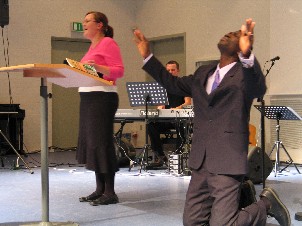 |
The independent churches, also called free churches because of their status compared to the Evangelical Lutheran Church in Denmark, often – as the Bible Centre of the Living Word in Aarhus at the photo – practice their faith by worshipping and performing ritual acts such as healing by prayers, music, and physical contact. Parts of the established church circles have reacted against the atmosphere of these sometimes spectacular devotional services by describing it as close to hysteria. Nevertheless, they have been able to attract many religious seekers, as well as ordinary people without any particular experience with church life prior to their enrolment. Photo: René Dybdal Pedersen
To sum up, the growing religious variety, and its informal structures, is reflected through our post-modern era. When trying to draw attention to their agendas, local authorities, social and local engaged groups, as well as the bona fide organisations, are facing some obstacles when they try to establish support and common understanding for their course of action. The primary reason for this situation is not necessarily lack of concern for the objects of discussion, but the overwhelming focus of the individual, which is penetrating throughout the society. At present, it seems that the best way of overcoming this problem is to direct the efforts towards the individual, i.e. activities that is designed to attract him or her, in our case about religious and spiritual matters, and at the same time create a pleasant, social atmosphere to make the issues easy to identify with, and engage in.
 |
This medieval painting from the Dome of Aarhus incorporates feeling of national and religious identity, as well as the hope for justice and salvation. Photo: René Dybdal Pedersen
See also Introduction and Original Project Description.
Back to the start of Project Description – or the Pluralism Project Presentation
Back to Centre for Multireligious Studies Presentation
We are very much interested in cooperation and in sharing insights and would highly appreciate any news from anyone dealing with research projects similar to ours. On behalf of the team of researchers
| | Marianne Qvortrup Fibiger Research Coordinator, Associate professor, Department of the Study of Religion The Faculty of Theology, University of Aarhus, Building 443, DK 8000 Aarhus C, Denmark mf@teo.au.dk http://cas.au.dk/ Tel. +45 8942 6718 |